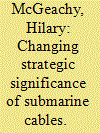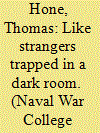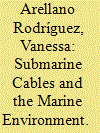|
|
|
Sort Order |
|
|
|
Items / Page
|
|
|
|
|
|
|
| Srl | Item |
| 1 |
ID:
185168


|
|
|
|
|
| Summary/Abstract |
The strategic significance accorded to submarine cables has never been a static concept, but it has been homogenous: a focus on protecting cables from external threats. This article argues that because submarine cables have long had strategic value, they provide a means to examine the emerging concept of strategic technology competition between the United States and China. To do so, this article examines major changes to the submarine cable sector since 2015, including the success of Chinese company Huawei Marine, and US and other western government interventions in several cable projects. It characterises the strategic considerations exhibited by submarine cable activity in that period – influence building in third countries, a changing perception among the US and its partners of threat and protection priorities, and closer attention to cable security and surveillance considerations – and compares them with the traditional strategic values attached to submarine cables. It concludes strategic concerns about undersea cables includes a new concept: the construction and installation of cables as a strategic threat, and which adds complexity to a sector in which it is difficult to project influence. This article seeks to make a contribution to scholarship on strategic competition in emerging technologies.
|
|
|
|
|
|
|
|
|
|
|
|
|
|
|
|
| 2 |
ID:
133393


|
|
|
|
|
| Publication |
2013.
|
| Summary/Abstract |
This work begins in the early twentieth century, when Great Britain stood at the center of the first modern global economy. The dream of British free-trade liberals was coming true; world trade was expanding, and economists, financiers, and business leaders in many nations were working to eliminate tariff barriers and expand international trade and finance. Three things made this expansion possible. The large British steam-powered merchant marine, watched over by the Royal Navy, was making it possible for buyers and sellers of many goods to have confidence that products would be shipped on time. Second, as Nicholas Lambert observes in Planning Armageddon: British Economic Warfare and the First World War, the "huge explosion in international trade after 1870 was made possible largely by the development of the London credit market," which allowed vendors to ship goods to purchasers on the guarantee that payment had been made and would find its way through London to the vendors' banks. Third, the creation of reliable submarine cables allowed vendors, purchasers, and banks to communicate almost instantaneously across whole oceans, facilitating the various messages that in their turn made international commerce possible.
|
|
|
|
|
|
|
|
|
|
|
|
|
|
|
|
| 3 |
ID:
179281


|
|
|
|
|
| Summary/Abstract |
Undersea communication cables are the core critical infrastructure of the digital age. 99% of all transoceanic digital communication—financial transactions, emails, or voice messaging—is transported through undersea fiber-optic cables. The global submarine cable network is a critical infrastructure that does not receive the analytical attention it deserves. We argue that cable security is a core dimension of current and future international security governance. We present the first systematic survey of the academic discourses that investigate the politics, governance, and protection of submarine data cables. Three rather narrow literatures study the cables (1) as under threat from hybrid warfare and terrorism, or treat the cable network narrowly as a (2) technical or (3) regulatory problem. We demonstrate the need for broadening out the research agenda and addressing key questions of security governance and geopolitics of this increasingly critical infrastructure.
|
|
|
|
|
|
|
|
|
|
|
|
|
|
|
|
| 4 |
ID:
181406


|
|
|
|
|
| Summary/Abstract |
Renowned for its unique flora and fauna, the Galapagos Archipelago is also home to a growing population of more than 25,000 people. Despite receiving approximately 200,000 tourists each year, and having governmental and nongovernmental offices, two airports, and various other human developments, the Archipelago’s telecommunications remain largely dependent on satellites. The absence of submarine telecommunication cables has not gone unnoticed, and the Archipelago is currently in the spotlight for two potential submarine cable projects. Although the environmental impact of submarine cables is generally deemed to be minimal, the pressure that new anthropogenic activities may add to the Galapagos cannot be disregarded. Two important aspects warrant specific attention in this regard: The Galapagos Archipelago’s surrounding waters have been designated as a marine protected area (MPA) and also a particularly sensitive sea area (PSSA) by the International Maritime Organization (IMO). Hence, using the Galapagos as a case study could serve as yardstick from which to assess the central question of this article: To what extent can coastal states regulate submarine cable operations for the protection and preservation of the marine environment?
|
|
|
|
|
|
|
|
|
|
|
|
|
|
|
|
|
|
|
|
|